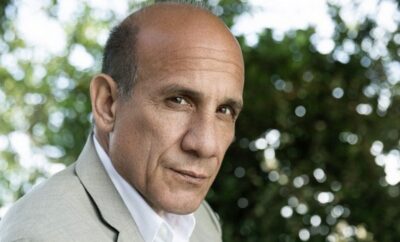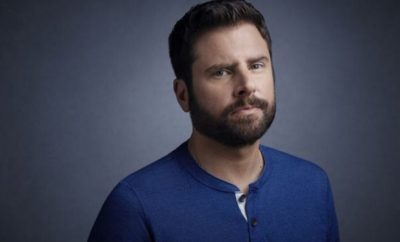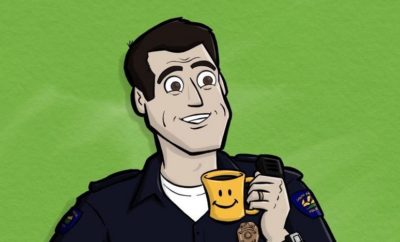Features
Brad Raider – Kensho at the Bedfellow
By: Nicole Smith
“Getting into Bedfellow with Brad Raider”
An odyssey of film, theatre, consciousness and collaboration
Brad Raider has spent the better part of his life on a stage or in front of a camera, but in his new film Kensho at the Bedfellow Raider is a triple threat. He puts his directing, writing and acting skills to the test — one that is aced in a message of self-discovery and hope.
Raider said he knew from the time he was a child that he wanted to be an actor and make movies. “It was Richard Donner’s 1978 Superman that ultimately did it for me,” he said. “I remember putting together — at a very young age — that beyond this character on the screen that I loved so much … there was this other guy, Chris Reeve, who was playing the role. I thought, ‘If I can’t be Superman himself, then that’s what I want to do.’ It was a simple, childlike revelation, but it charted the course of my life.”
As a kid, he performed in almost every school show from elementary through high school, including a one-man-show about the life and films of Frank Capra his senior year of high school. As it turned out, it wouldn’t be the last time the theatre and film worlds would collide in his work. At the Cheltenham Arts Center (just outside of Philadelphia where he grew up), Raider met Greg Feinberg, the first of many life-long collaborators. “Greg and I very quickly found simpatico over our love of theatre, Back to the Future, magic and just being these subversive 11-year-old artists. It’s so important at that age to meet like-minded kids and we were lucky to find one another,” he said. “We started making little movies together — in those days, it was on VHS tape. We would shoot on these enormous camcorders, play all the roles, edit on two VCRs with a mess of RCA cables attached and add music from our favorite soundtracks like Aliens and The Untouchables. It was awesome — and Greg has a massive NSA-like archive of it all somewhere in Pennsylvania.”
The two later stepped up their game at Long Lake Arts Camp in the Adirondacks where several experiences and mentors would directly influence Kensho almost thirty years later. “Those early years and my friendship with guys like Greg are still profoundly inspiring in my life and work,” Raider said. Another equally inspiring collaboration would form at NYU’s Tisch School of the Arts, where Raider studied theatre and film after graduating high school. “I was at my locker at the Experimental Theatre Wing and this kid comes up to me. I had seen him around and he was a little moody and mysterious, but we never really spoke,” Raider said. “He told me that he really dug my work in this weird, avant-garde play I did and that he really wanted the role that I played (a crazy, sex maniac in an insane asylum), and he told me that he didn’t think anyone else was possibly capable of playing the role as well as he could’ve … but after seeing me in it, he decided he probably wouldn’t have done it much better. … I was like, ‘Wow, thanks dude.’ His name was James Rodriguez. I later became equally impressed with his work, as well as his virtual encyclopedic knowledge of movies and all things 80’s.” Raider and Rodriguez (who later, of course, would become Psych’s James Roday) were fast friends.
As time went by, the two performed in a storefront Shakespeare production, in a place that Raider describes as an “old shoe store.” After both working the graveyard shift for a while so they could make theatre during the day (another inspiration for Kensho), they eventually went their separate ways for work. Raider says Roday was having success with pilots in Los Angeles and he decided to stick with theatre in New York. That is until his friend came calling…Roday had already helped remotely with a production of Henry V that Raider starred in and produced in New York (Raider credits this as the beginning of their collaboration), but now Roday was encouraging him to come out west to try his hand in television. “I had done a tiny role on Spin City when Michael J. Fox was starring — which for my Back to the Future buddy, Greg, was mind-blowing. I thought, ‘Well, at least I have some TV experience. If it doesn’t work out, I can always come back to New York and do plays.’ I packed a duffel bag, flew out to LA and slept on James’ couch,” Raider said. “I was driving around to auditions in our friend Todd’s car, God bless him. … My second or third day, I read for an ABC pilot that they were recasting called The Trouble With Normal. They were looking for a ‘New York actor’ and I had just come off starring in Henry V in New York. Of course, no one knew that I produced the thing myself, but this business is as much about perception as anything and at the very least that got me into the room. After two weeks of callbacks and network tests, they took a chance on me and the show ended up going to series for 13 episodes. It was an incredibly lucky break. I got to work with amazing people and it was a real game-changer in my early career. I could also afford to move off of James’ couch.”
While the television-acting bug had bitten Raider, he still wanted to do theatre with his friend and the two rented out a space in Hollywood to perform David Mamet’s Sexual Perversity in Chicago, which birthed their nonprofit theatre company, Red Dog Squadron. “It came time to name the company and so we looked to the play itself. There’s a line in the beginning of the play between Bernie and Danny, the two characters that James and I played. Bernie is recounting an encounter he had the night before with a young woman who has an airplane fetish,” he said. “They’re making love, and she starts yelling, ‘Red Dog One to Red Dog Squadron’, and I thought, ‘That’s it!’ Now, it should be noted that James wanted to name the company ‘The Naked La-Las’ (which is also a line in the play), but I was like, ‘Buddy, Red Dog Squadron is so much cooler! The Naked La-Las sound like a kinky Eastern European folk band.’ Thankfully, common sense prevailed and now, of course, ‘squad’ and ‘squadron’ have become hashtags for like-minded collaborators doing cool stuff. Hopefully, we’re living up to that.”
As the years passed, Red Dog Squadron continued to produce work and Raider had many television roles, including a half-dozen pilots, canceled series’ and work on Jericho, Modern Men and Psych, to name a few. Starring roles in indie films came as well and started planting the seeds for making his own movie. “It was a really interesting time when I started developing Kensho. The TV work began to plateau and I found myself just kind of spinning the wheels. But that plateau, as is often the case, was incredibly important for my creativity, as was meditation, which I learned around the same time,” he said. “Having this simple, little practice where I could settle-in and experience a deeper part of myself became supremely helpful in my work and peace-of-mind. And I found that so many people I respected were doing it, too. I started traveling with and apprenticing my teacher and he later trained me to teach, as well.” Raider now teaches meditation privately through his company, MDT8, and many of his students are in the film and TV business. Raider credits his “spiritual journey in the wilderness” as a big influence on Kensho. Not only did many in the cast and crew of Kensho have a practice of yoga and meditation (several of whom were taught by Raider, himself) but also the mediation community that Raider found himself in after practicing for ten years rallied behind the project, donating locations and resources for the film. And the wisdom of Eastern philosophy, itself, made its way into the narrative.
“Kensho,” in fact, is a Zen Buddhist term that means “awakening” or “seeing one’s truest nature.” The main character, Dan,(played by Raider) is a NYC playwright turned overnight doorman (at the Bedfellow Hotel) trying to come to terms with his sister’s death from substance abuse. Dan has become self-destructive, nihilistic and desperate for an elusive sense of freedom and fulfillment. “There’s a lot of me in Dan and a lot of Dan in me,” Raider said. “But there’s a lot of me in all of the characters. Dan’s maybe someone that I used to be, times ten, with problems that I haven’t necessarily struggled with, but that I can certainly empathize with,” he confesses. The inspiration for Dan’s sister, April, (portrayed by Michelle Cameron) came from Raider’s own sister and her former struggles with substance abuse, which she eventually overcame. “The relationship I have with my sister was one of the initial sparks I had for the narrative. We’re very close, and I knew that relationship had a powerful resonance with me,” he said. “Dan and April’s relationship is the emotional center of the film and I could really lean on my real-life experience as the story began to take shape. The film is really a love letter to my family — my brother, father and mother all played equally important roles in the IRC storyline.” The IRC (International Rescue Committee) came on board in support of the film based on Raider’s depiction of them in the script. He says he drew on his mother’s humanitarian and peace-building work in crafting the character of Kate (Kaley Ronayne), who works for the IRC. “The IRC is on the front-lines in forty countries around the world doing amazing work — everything from emergency response to health care to refugee resettlement. Last year, they helped over 17 million people,” Raider shared.
It’s no surprise that Raider’s collaborations with Feinberg and Roday significantly shaped the relationship between Dan and his friend Max (Steven Klein) — a theatre director that has had a long-term collaborative friendship with Dan, a friendship that’s put to the test when Dan begin to spiral out of control. “Max’s central thru-line is this low-level anxiety of not mattering, both as an artist and as a man. You know, ‘If I don’t accomplish x, y and z, then I won’t be remembered or appreciated.’ And I think that’s what many artists and non-artists, alike, are ultimately afraid of. It’s not necessarily death that they fear; it’s the possibility that they won’t have any significance while they’re alive,” Raider said.
He says one of the toughest parts of making Kensho was wearing multiple hats as the lead actor, director and writer, but he constantly found inspiration in the collaborative process. Raider said scenes like the one between Dan and Mosi (Sahr Ngaujah) solidified his reasons for pushing the project forward. When Mosi (a refugee from South Sudan) shares with Dan the story of his resettlement, there were simple technical considerations to pull off. Raider said the scene was shot in the middle of the night in his aunt’s Brooklyn apartment and took seven or eight takes, two close-ups and one dolly shot to capture dialogue in which Dan begins to understand more about the world around him and his place within it. “I had done a ton of research before writing the scene, and of course, the IRC’s involvement later became equally important. Casting Sahr was everything and I have Sabrina Hyman (our casting director) to thank for that. Sahr is just extraordinary in the film,” he said. “So all of these elements started coming together. I worked with my composer, Aaron Gilhuis, on the score for six months and he did an incredible job. The piece of music for Mosi’s scene was particularly important to us. David Rodriguez’s cinematography, Hannah Stoddard’s production design, the editing, color grading, sound mix … all of these things come together for every moment of the film and in the case of Mosi’s scene, it becomes so much larger than just the combination of elements involved.” He continued, “I’m so proud of everyone’s work on the film. There are so many talented actors, technicians, artists — just a huge army of people inspired by the material, inspired by each other, inspired by collaboration. And as a director, that’s one of your primary jobs — to inspire collaborators to do their best work with your vision.”
After premiering at the Harlem International Film Festival in New York, receiving the New York Showcase Award and making a west coast premiere at the Awareness Film Festival in Los Angeles, Raider says he’s seeking other festival venues for Kensho along with distribution possibilities. Looking forward, Raider plans to continue acting, writing and directing while teaching meditation on the side. He’s also busy prepping the eagerly-anticipated opening of the brand-new Circle Theatre in Los Angeles, now the home of Red Dog Squadron and The Black Dahlia, as the artistic headquarters for both his and Roday’s collaborators in film, TV and theatre. “We really want The Circle to be a communal space that involves other theatre companies, community outreach, as well as programs from other disciplines,” he said. “Roday and I thrive off of that sense of play and building things together. It was, in many ways, cultivated at the Experimental Theatre Wing: wrestling with ideas and with our own artistry, but doing it in a highly creative, ensemble-based environment.”
Raider hopes that Kensho can serve as a “socially-relevant and consciousness-based platform for expression” — a film that’s both entertaining and inspiring. “I think we have an opportunity as filmmakers, theatre makers and artists. What are we putting out there into the collective? How are we expressing ourselves and why?” Raider said. “Art and storytelling are as vital to the human experience as anything, and so it becomes a bit of a responsibility to be artful in the artistry of it. How can we make things that challenge us to grow, that aid in our individual and collective evolution? And most importantly, how can we do it in a ridiculously entertaining way?”
To learn more about Kensho at the Bedfellow, visit www.kenshofilm.com
For more on MDT8, visit www.MDT8.com and for more on RED DOG SQUADRON, visit www.reddogsquadron.com
Special thanks to Daniel Gilmore for his contribution.





You must be logged in to post a comment Login